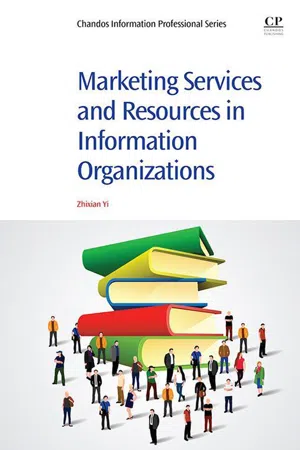
- 154 pages
- English
- ePUB (mobile friendly)
- Available on iOS & Android
Marketing Services and Resources in Information Organizations
About this book
With the rapid development of information and communication technology and increasingly intense competition with other organizations, information organizations face a pressing need to market their unique services and resources and reach their user bases in the digital age. Marketing Services and Resources in Information Organizations explores a variety of important and useful topics in information organisations based on the author's marketing courses and his empirical studies on Australian academic librarians' perceptions of marketing services and resources. This book provides an introduction to marketing, the marketing process, and marketing concepts, research, mix and branding, and much more. Readers will learn strategic marketing planning, implementation, and evaluation, effective techniques for promoting services and resources, and effective social media and Web 2.0 tools used to promote services and resources.Marketing Services and Resources in Information Organizations is survey-based, theoretical and practical. The advanced statistical techniques used in this book distinguish the findings from other survey research products in the marketing field, and will be useful to practitioners when they consider their own marketing strategies. This book provides administrators, practitioners, instructors, and students at all levels with effective marketing techniques, approaches, and strategies as it looks at marketing from multiple perspectives.Dr. Zhixian (George) Yi is a Leadership Specialization Coordinator and Ph.D. supervisor in the School of Information Studies at Charles Sturt University, Australia. He received a doctorate in information and library sciences and a PhD minor in educational leadership from Texas Woman's University, and he was awarded his master's degree in information science from Southern Connecticut State University. In 2009, he was awarded the Eugene Garfield Doctoral Dissertation Fellowship from Beta Phi Mu, the International Library and Information Studies Honor Society. He was selected for inclusion into Who's Who in America in 2010.- Examines effective marketing techniques, approaches and strategies- Studies marketing from multiple perspectives- Empirical-based, theoretical, and practical- Systematic and comprehensive
Frequently asked questions
- Essential is ideal for learners and professionals who enjoy exploring a wide range of subjects. Access the Essential Library with 800,000+ trusted titles and best-sellers across business, personal growth, and the humanities. Includes unlimited reading time and Standard Read Aloud voice.
- Complete: Perfect for advanced learners and researchers needing full, unrestricted access. Unlock 1.4M+ books across hundreds of subjects, including academic and specialized titles. The Complete Plan also includes advanced features like Premium Read Aloud and Research Assistant.
Please note we cannot support devices running on iOS 13 and Android 7 or earlier. Learn more about using the app.
Information
Introduction to Marketing
Abstract
Keywords
1.1 What is Marketing?
Table of contents
- Cover image
- Title page
- Table of Contents
- Copyright
- Dedication
- Biography
- Foreword
- Preface
- Acknowledgments
- Chapter One. Introduction to Marketing
- Chapter Two. Market Research
- Chapter Three. Techniques for Identifying Users’ Needs and Wants
- Chapter Four. Market Segmentation, Targeting, and Positioning
- Chapter Five. The Marketing Mix and Branding
- Chapter Six. Strategic Marketing Planning
- Chapter Seven. Marketing Implementation and Evaluation
- Chapter Eight. Techniques for Promoting Services and Resources
- Chapter Nine. Techniques for Marketing Electronic Resources
- Chapter Ten. Social Media Marketing
- Chapter Eleven. The Future of Marketing Services and Resources
- Glossary
- Index